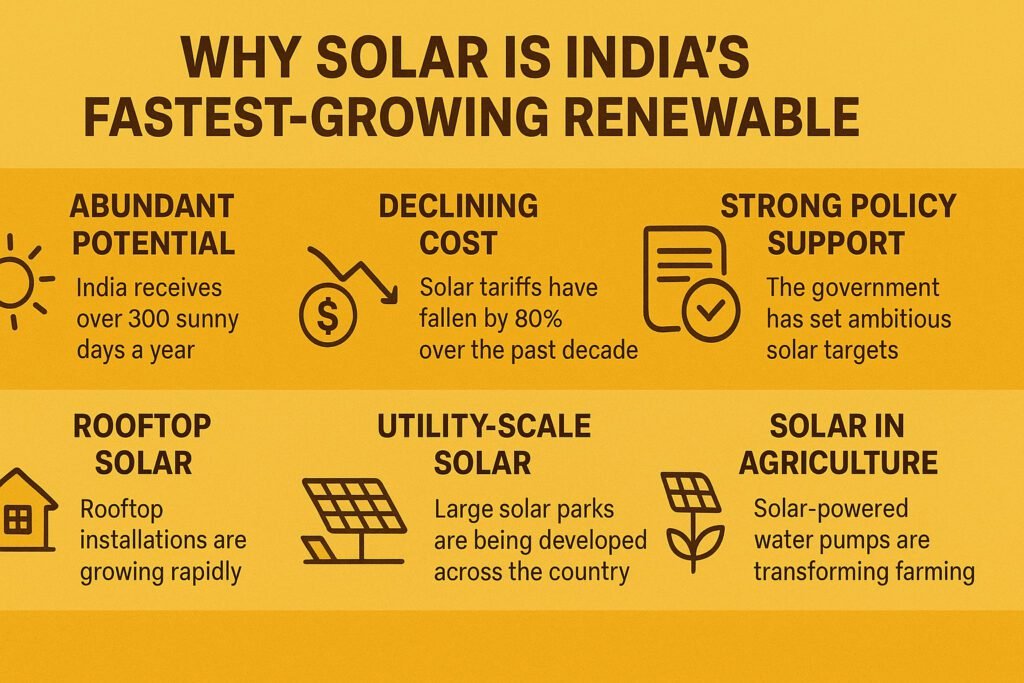India stands at the crossroads of an energy revolution. With a growing population, rapid urbanization, and rising industrial demand, the country’s appetite for electricity is immense. At the same time, the global climate crisis and India’s own sustainability goals have made renewable energy an urgent necessity. Among the various renewable options—wind, biomass, hydro, and geothermal—solar energy has emerged as the fastest-growing renewable in India.
From rooftop installations in cities to vast solar parks in deserts, India has become one of the world’s leading solar markets. This meteoric rise is not coincidental but the result of favorable geography, supportive government policies, falling technology costs, and increasing private sector participation.
1. India’s Energy Landscape
India is the world’s third-largest consumer of energy and electricity. Traditionally, coal has been the dominant source, accounting for around 70% of power generation. However, heavy dependence on coal has led to rising emissions, pollution, and import bills.
To address these challenges, India has embraced renewables as part of its National Solar Mission (2010) and broader commitments under the Paris Agreement. Today, renewables contribute over 40% of India’s installed capacity, with solar leading the charge.
2. Why Solar is Surging Ahead
a) Abundant Solar Potential
India receives over 300 sunny days a year, with an average solar insolation of 4–7 kWh/m² per day. The theoretical potential exceeds 750 GW, making solar an inexhaustible and geographically widespread resource. Unlike wind or hydropower, which are location-specific, solar can be harnessed almost anywhere—urban rooftops, rural fields, deserts, and industrial complexes.
b) Declining Costs
In the past decade, the cost of solar power has fallen by more than 80%. In many cases, solar tariffs in India are now lower than coal-fired power, with record low bids around ₹2–₹2.5 per unit. This cost competitiveness has made solar the most attractive choice for both utilities and consumers.
c) Strong Policy Support
Government initiatives have provided solar with a strong push:
-
National Solar Mission (2010): Set ambitious capacity targets.
-
Renewable Energy Development Agencies (MNRE & SECI): Driving auctions and incentives.
-
100 GW solar target by 2030: As part of India’s commitment to reach 500 GW of renewables by 2030.
-
PLI (Production-Linked Incentives): Encouraging domestic solar panel manufacturing to reduce import dependence.
d) Flexibility of Deployment
Solar projects can range from small rooftop systems for homes and shops to giant solar parks like Bhadla (Rajasthan), which spans 14,000 acres. This scalability gives solar an edge over hydro or biomass, which require large investments and specific conditions.
e) Private Sector and FDI Participation
Major corporations like Adani Green Energy, Tata Power Solar, and ReNew Power have invested heavily in solar. International players, including global investors and technology firms, are also pouring capital into India’s solar sector, attracted by its scale and growth prospects.
3. Solar Applications Driving Growth
Utility-Scale Solar Parks
Large-scale solar parks are the backbone of India’s solar growth. Mega projects in Rajasthan, Gujarat, Madhya Pradesh, and Karnataka are contributing thousands of megawatts to the grid.
Rooftop Solar
Urban India is seeing rapid adoption of rooftop solar on residential apartments, offices, and shopping malls. Net metering policies allow consumers to sell excess power back to the grid, making rooftop solar financially attractive.
Solar in Agriculture
India’s vast agricultural sector is increasingly powered by solar water pumps and off-grid solar systems. The KUSUM scheme supports farmers in adopting solar irrigation, reducing reliance on expensive diesel pumps.
Solar for Rural Electrification
In remote villages where grid connectivity is weak, decentralized solar microgrids and home systems are providing affordable, clean power, bridging India’s energy access gap.
Industrial and Commercial Usage
Factories, warehouses, and IT parks are adopting solar to cut energy bills and reduce their carbon footprint. This trend is accelerating with ESG (Environmental, Social, Governance) commitments by corporates.
4. Economic and Social Benefits
a) Job Creation
The solar industry has become a massive employer, from panel manufacturing to installation and maintenance. By 2030, solar is expected to create millions of green jobs across India.
b) Energy Independence
Solar reduces India’s dependence on imported coal and oil, saving billions in foreign exchange and improving energy security.
c) Rural Development
By powering farms, schools, and villages, solar energy is transforming rural India, enabling education, healthcare, and livelihoods.
d) Lower Power Costs
As costs decline, industries and households benefit from cheaper electricity, boosting competitiveness and savings.
5. Challenges Facing Solar Growth
Despite its impressive progress, solar faces some hurdles:
-
Land Acquisition: Large solar parks require vast tracts of land, leading to conflicts in some regions.
-
Intermittency: Solar generates only during daylight; without storage, it cannot ensure 24/7 supply.
-
Grid Integration: Rising solar capacity stresses India’s aging grid infrastructure, requiring upgrades.
-
Dependence on Imports: Despite domestic efforts, much of India’s solar equipment is imported from China, raising concerns over supply chain security.
-
Financing Issues: Small-scale rooftop projects often face challenges in securing affordable financing.
6. The Future of Solar in India
The future of solar in India looks promising, driven by both necessity and opportunity:
-
Hybrid Systems: Solar combined with wind or storage solutions can provide more stable power.
-
Battery Storage: Falling battery costs will enable solar to become a 24/7 power source.
-
Floating Solar: With limited land, floating solar projects on reservoirs and dams will gain traction.
-
Domestic Manufacturing: Government incentives will strengthen India’s solar manufacturing base, reducing reliance on imports.
-
Smart Grids: Integration of AI and digital technologies will make grid management more efficient.
By 2030, experts project that India could have over 280–300 GW of solar capacity, making it the largest single contributor to India’s renewable energy mix.
7. Global Significance
India’s solar growth is not just domestic—it has global implications. As one of the world’s largest carbon emitters, India’s shift toward solar will play a pivotal role in fighting climate change. Through initiatives like the International Solar Alliance (ISA), headquartered in Gurugram, India is also leading global cooperation in solar development, helping other nations harness solar power.

